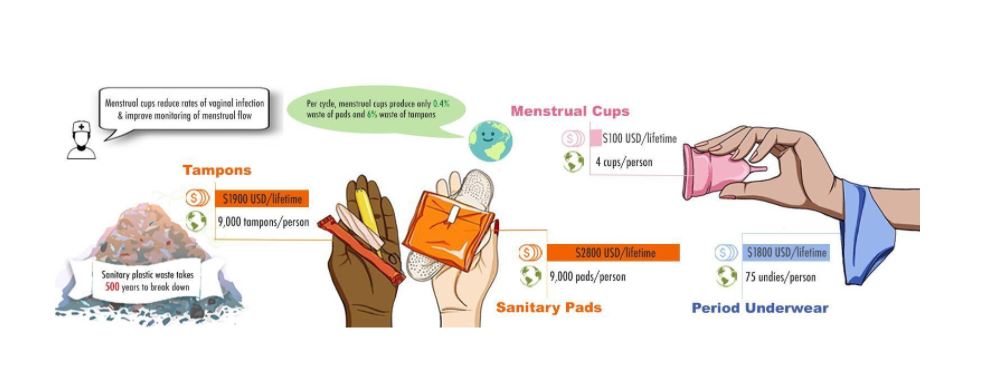The covid-19 pandemic has highlighted our dependency on single-use healthcare products worldwide, despite their increased cumulative costs, elevated susceptibility to supply chain strains and significant environmental impacts. The most prominent symbol of single-use covid-19 products is the face mask. However, even before the pandemic, we have already been facing a tide of waste driven by the less commonly discussed single-use menstrual products such as tampons and pads.
The ecological burden of single-use menstrual products is significant. These products contain significant amounts of plastics that end up in landfills or in our water systems. Consistent usage of reusable alternatives such as menstrual cups and menstrual underwear significantly reduces the amount of plastic waste generated (by 99.6% in comparison with pads; by 94% relative to tampons). Menstrual cups are flexible cups that are placed intravaginally to collect menstrual flow and are made with medical-grade rubber, silicone, or latex that can last up to 10 years. Menstrual underwear resemble typical underwear, but include additional absorbent and leak-resistant layers to collect menstrual flow. Menstrual cups and underwear need to be emptied or changed every day throughout menstruation in accordance to menstrual flow patterns similar to their single-use counterparts; however, they are designed to be washed, reused, and last for years. As medical students, we see an important role for healthcare providers to play in introducing these products to patients who menstruate, due to their important environmental, financial, and health co-benefits.
Reusable menstrual products could help mitigate “period poverty,” which is an experience whereby people who menstruate need to resort to alternative and less sanitary means of managing their periods due to financial barriers. Period poverty is highly prevalent as single-used menstrual products are not always financially accessible. The estimated cost of single-use tampons and pads is about $160 USD per year. A recent study also identified that one-third of Canadian women under the age of 25 have struggled to afford menstrual products. There are accumulating economic advantages to the long term use of reusable menstrual products, albeit there may be higher up-front costs; the estimated cumulative purchasing costs of menstrual cups over a person’s lifespan is only 5% of the cost of pads and 7% of that of tampons. Thus, promoting reusable alternatives can also play a role in increasing access to menstrual products and alleviating period poverty.
Furthermore, there is a growing body of literature that has identified notable health benefits for the use of menstrual cups, such as a reduced prevalence of vaginal bacterial infections and improved monitoring of menstrual flow to help manage patients with heavy menstrual bleeding. The menstrual cup has also been demonstrated to increase satisfaction relative to the continued use of tampons in a cohort of women who were previously primarily using tampons in a randomized-controlled trial, with 91% of women randomized to the menstrual cup group willing to continue the use of the cup after the study period and to recommend it to others. Despite these benefits, reusable alternatives such as menstrual cups or period underwear continue to be underutilized by people who menstruate due to lack of awareness, the continued societal stigma around speaking about menstruation and misconceptions regarding cleanliness, hygiene, and discomfort.
Healthcare professionals play an essential role in health promotion, and in healthcare environments, patients are routinely counselled to learn about potential health risks and to prevent disease with lifestyle management. Taken together with the consistently strong trust that the public holds for physicians and healthcare professionals, the aforementioned benefits of reusable menstrual products make the physician’s office particularly well-positioned to discuss, encourage and counter misinformation regarding the utilization of reusable menstrual products with patients who menstruate. However, physicians and other members of the primary care team often don’t provide menstrual education and patient counselling and thus miss opportunities to discuss the evidence-based health, quality of life, financial and environmental co-benefits of reusable menstrual products in waiting rooms and examination rooms.
Infographics are powerful visualization tools that have been shown to allow patients to understand information on specific diseases, procedures, and trending healthcare topics more quickly and easily. As medical students, we have designed an infographic-based resource to make the conversation easier. These important dialogues present vital opportunities for physicians and other health professionals to empower patients to reduce their ecological footprints and out of pocket costs. We believe that the intersecting crises of climate change and period poverty can be addressed not only in the drug store aisle and on social media, but in the doctor’s office as well.
Owen Dan Luo, medical student, Class of 2023, McGill Faculty of Medicine and Health Sciences.
Jiayin Huang, medical student, Class of 2023, McGill Faculty of Medicine and Health Sciences.
Shiyang Shen, medical student, Class of 2023, McGill Faculty of Medicine and Health Sciences.
Competing interests: none declared.
Infographic resource for physicians and other healthcare providers to inform patient counselling on reusable menstrual products. Average lifetime menstrual product usage and financial cost estimations were made based on the best available evidence with sources accessed in Feb 2021. Full calculations and sources available upon request.
Acknowledgements: Thank you to Karen Born for her expertise in reviewing this commentary and for her unwavering support for the sustainable and high-value healthcare community.

